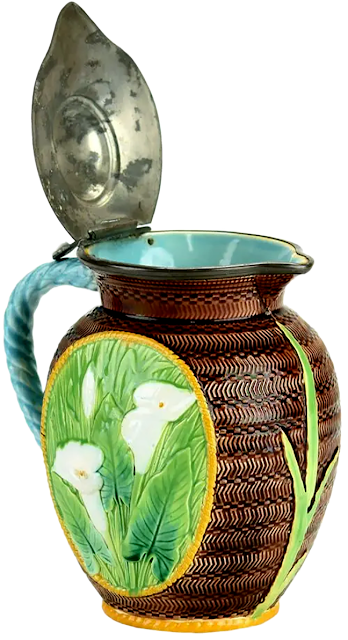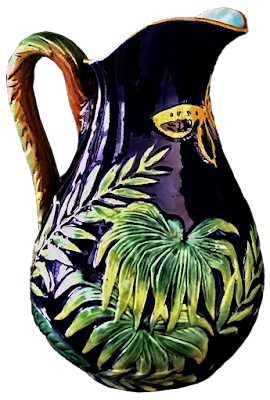George Jones majolica Monkey Handled Cream Jug
There is no denying the popularity of George Jones majolica. My blog posts on George Jones consistently receive the highest hits of all the posts I do. That made me think that a Majolica Spotlight on their glorious pitchers would be of general interest to my readers.
In doing research on these pitchers I was often frustrated by the incomplete George Jones majolica pattern books available to us today. Unfortunately we have no other means of knowing how many different pitchers were made nor how the pitchers were identified within the factory nor the number of sizes they were made in. Because of this, when a pattern name is not available I'll identify the pattern by the pattern number.
They also repeated some names in-house for different patterns which makes things more difficult. In the illustration below from the pattern books, two pairs of pitchers share the same name. Two pitchers, the one in the top right and the one directly below it share the name Foliage Jug. At the bottom, the pitcher on the right corner and the one on the left corner share the name Basket Jug.
I’m sorry to say there are some pitchers which we know little or nothing about aside from being made by the company. I will include them also. I am not including small creamers that were integral components to other pieces such as strawberry servers.
Registered pitcher designs from the George Jones pattern book
I should also mention that different color variations of the same pitcher were occasionally given different pattern numbers. This may be because of differences in the mold or some other unknown reason; there's really no way to know for sure. The pattern numbers given refer to the examples shown, when available.
Of all the pitchers George Jones made, I would guess that his Chestnut pattern pitcher, pattern 1809, is likely one of the most sought after. It regularly brings high auction prices and is very much in demand among enthusiasts. Maybe it’s the rarity or maybe it’s the spray of chestnut flowers on the side. Whatever it is, collectors love it! Who can blame them? It’s a lovely design. Although the GJ Catalog listing on this jug is incomplete, I have been able to confirm that there are at least four sizes: 6 oz., 12 oz., 24 oz. and 30 oz.. Of these four there are three different variations in design. The largest of these was designed with a small attached foot. In my experience this is seen most frequently in large jugs made as part of a dresser jug and wash bowl set though I have never seen a washbowl in this pattern. The next size came in two distinct variations: one has a larger attached footed base and the other a twig footed base. The smaller sizes both have the larger attached footed base. The pattern number is 1809.

George Jones majolica large Chestnut Jug
George Jones majolica attached foot Chestnut Jug
George Jones majolica twig footed Chestnut Jug
Another highly coveted design is the Jones Sea and Sky Jug, pattern 5246. Very rarely seen on the collector's market, this pitcher was made in four sizes: 6 oz.; 12 oz.; 24 oz.; and 30 oz. These pitchers are wonderful in their detail.
George Jones majolica Sea and Sky Jug
One jug that is commonly available as well as one of my personal favorites is the Wild Rose Jug, pattern 3449. I did a Majolica Showcase on this design here. I have seen this pitcher in two variations, a conventional jug and a smaller creamer. Wild Rose too was made in 6 oz., 12 oz., 24 oz., and 30 oz. sizes.
George Jones Wild Rose cream pitcher
George Jones majolica Wild RoseJug
A pitcher similar in shape to the
Chestnut Jug is the Jones
Lotus Jug, pattern 1800. It is a design of lotus flowers, leaves and cattails against a barrel type ground. This pitcher came in four sizes: 6 oz., 12 oz., 24 oz., and 30 oz.
George Jones majolica Lotus Jug
A Jones pitcher that is sometimes sold as part of the
Hops beer set is the
Barrel Jug, pattern 1846. Made in four sizes–6 oz., 12 oz., 24 oz. and 30 oz.–the
Hops beer set, consists of the 24 oz. or 30 oz.
Barrel Jug, two mugs and a trefoil tray.
George Jones majolica Barrel Jug

A Jones pitcher that is often overlooked because of it’s plain design is the Mottled Jug, Rope Handle, pattern design 2777 which came in four sizes: 6 oz., 12 oz., 24 oz. and 30 oz.
GJ majolica Mottled Jug, Rope Handle
Another George Jones pitcher that is often overlooked is the Basket Jug, pattern 2792. It also came in four sizes, 6 oz, 12 oz., 24 oz. and 30 oz.
George Jones majolica Basket Jug
George Jones majolica Basket Jug with pewter lid
A terrific compliment to the Monkey handled tea set, the Monkey Handled Jug, number 3458, is only listed in one size. The compliment cream jug to the Monkey Handled Teapot, is listed as part of the tea set, number 3450.
George Jones majolica Monkey Handled Jug
One of the most beautiful pitchers made by the company is the Iris Jug, pattern number 2509. The pattern books don’t list the number of sizes in which it was made but most likely it came in the same four sizes as most of the other pitchers.
George Jones majolica Iris Jug
Another strikingly beautiful pitcher is the Flowered Jug, pattern 3439, generally known among collectors as the orchid pitcher. It was made in four sizes, 6 oz., 12 oz., 24 oz. and 30 oz.
George Jones majolica Flowered Jug
One of the most commonly found GJ pitchers is the
Foliage Jug, pattern numbers 1806, 3346 and 3439. It came in at least four sizes and possibly more.
George Jones majolica Foliage Jug
A lovely elegant pitcher with lilies, the Calla Lily Jug, number 5215, came in at least four sizes.

Jones majolica Calla Lily Jug
GJ Calla Lily Jug with pewter lid
The Jones Stork Jug, number 3409 came in at least two sizes both with and without a pewter lid.
George Jones majolica Stork Jug
A Christmas favorite is the Holly Mask Jug, number 2776C, sometimes called the Father Christmas pitcher. This pitcher came in at least three, and possibly four sizes, both with and without pewter lid.
George Jones majolica Holly Mask Jug
A great favorite among collectors is the
Hunting Claret or Beer Jug, pattern number 3228, which was sold both with and without a cover.
GJ Hunting Claret or Beer Jug with cover
GJ Hunting Claret or Beer Jug
A marvelous expression of nature, the Bird’s Nest Jug with Bird Handle, pattern number 3440, has always been Jones nature design at its finest. It was made in four sizes, 6 oz., 12 oz., 24 oz. and 30 oz.
Jones majolica Bird’s Nest Jug with Bird Handle without cover
A sweet and very popular design with tiny frogs and a flowering chestnut tree, the Rustic Jug, number 3457, came in four sizes: 6 oz., 12 oz., 24 oz., and 30 oz.
George Jones majolica Rustic Jug
Clearly inspired by the influence of Japanese art, the elegant
Bamboo Jug, number 3256 came in four sizes 6 oz, 12 oz, 24 oz and 30 oz.
Jones majolica Bamboo Jug
The simple Basket Jug, number 3292, came in at least two sizes, and probably more.
George Jones majolica Basket Jug
A matching piece to the
Apple Blossom tea set and cheese bells, the
Apple Blossom Jug, came in five sizes 6oz, 12 oz. 24 oz., 30 oz, and 36 oz; pattern number 3303.
George Jones majolica Apple Blossom Jug
This registered Jones pitcher, the Basket Jug, was heavily copied by a contemporary pottery, possibly Hawley & Co., who had a contract with an American department store to copy English majolica patterns and furnish them at a cheaper price. Pattern 3578, it was made in three sizes: 12 oz., 24 oz., and 30 oz.
George Jones majolica Basket Jug
An unusual jug for George Jones, the
Bacchanalian Jug, or
The Cupid Dance Jug, number 5252B, relies on classical design for its inspiration. It was made in four sizes: 6 oz., 12 oz., 24 oz., and 30 oz.
George Jones majolica Bacchanalian Jug
A hard to find Jones pitcher, the
Foliage Jug, number 3346 is only listed in the pattern book as having one size although other sizes are certainly possible.
George Jones majolica Foliage Jug
The pitchers below by George Jones we have little or no information about.
GJ majolica sunflower jug, number 5262 (?)
George Jones majolica jug Judge, pattern number 1910 (?)
GJ pitcher sometimes referred to as the Hawthorn jug,
made in multiple sizes. Pattern number 3374.
George Jones majolica apple blossom jug,
similar to the monkey handled jug
GJ bird with ivy jug, pattern 5201 (?)
George Jones majolica pineapple creamer
George Jones crane and swallow jug, number 5241
I suspect there are other patterns I have not seen but should they surface I will update this post. This should give you a good idea of the large range of pitchers made by the company. One thing is certain—they are all beautiful.



















































